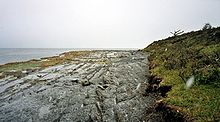Brunswick Peninsula
| Brunswick Peninsula | ||
 Brunswick Peninsula (red) |
||
| Geographical location | ||
|
|
||
| Coordinates | 53 ° 30 ′ 0 ″ S , 71 ° 25 ′ 0 ″ W | |
| Waters 1 | Strait of Magellan | |
The Brunswick Peninsula (also "Braunschweig Peninsula", Spanish Península de Brunswick ) is the southernmost part of the South American mainland , with the southernmost point Cape Froward . It is located in Region XII in Chile and on the Strait of Magellan . The largest city on the peninsula is Punta Arenas . The municipality of Punta Arenas consists of the peninsula and some neighboring islands.
Surname
The peninsula was named by English explorers in honor of Friedrich Wilhelm Duke of Braunschweig-Wolfenbüttel , who fought with the Duke of Wellington in the battle of Quatre-Bras against Napoleon in 1815; Friedrich Wilhelm died in the battle. Brunswick is the historical name of the city and the former Duchy of Braunschweig in Germany.
Others
The Laguna Parrillar National Reserve, established in 1977, is located on the peninsula, a good 50 km south of Punta Arenas . It has an area of 184 km² and is between 300 and 650 m above sea level. M.
Even further south are Puerto del Hambre (literally "Port of Hunger", French Port Famine ) and Fuerte Bulnes on Buena Bay . Pedro Sarmiento de Gamboa founded a settlement at Puerto del Hambre in March 1584 . The first Spanish settlers suffered starvation due to the barren vegetation. The English pirate Thomas Cavendish found the ruins of the settlement in 1587, and the ruins have enjoyed national monument status since 1968.
Interestingly, the Brunswick Peninsula is barely perceived as the southern end of South America. In this respect, Cape Horn , the Diego Ramírez Islands and Tierra del Fuego are overtaking it .

